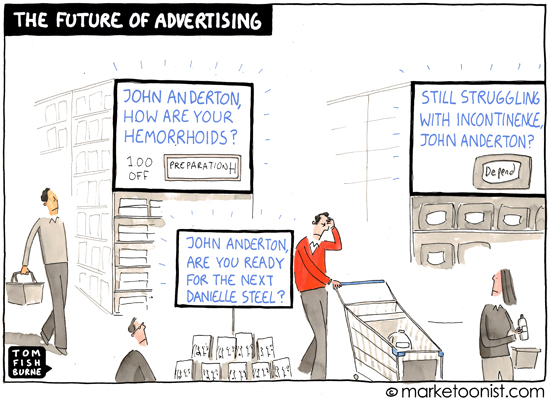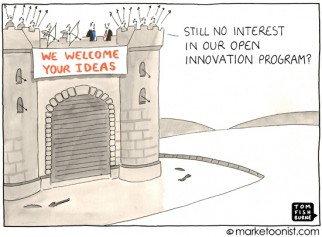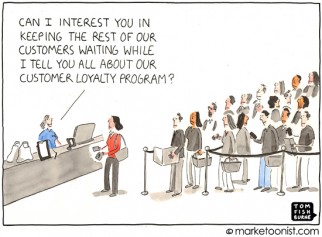One of the more memorable scenes from the 2002 movie Minority Report was a dystopian view of advertising in the year 2054. The protagonist, John Anderton, walks through a mall, where retina scanners match his identity with purchase history so that billboards can pitch personal ads to him as he walks by.
Consumers have been dreading this and marketers have been salivating over this ever since. We won’t have to wait until 2054. Much of the technology is already here. Retinal scanners may not be sophisticated enough (yet), but mobile phones are prime time ready.
A marketing firm called Renew caught flak last week in London for using WiFi-equipped recycling bins to track all the smart phones that passed by. The devices sniffed out certain information, including a MAC address unique to each phone.
Renew has referred to these MAC addresses as “cookies” for the offline world. In the same way that browser cookies prompt particular web site ads, these offline cookies could drive personalized billboards based on the information it knows about you.
While Renew pulled back from the trial, there will be more experimentation in personal advertising ahead. We can expect a lot of friction between privacy advocates and marketers as the technology evolves.
As with any new technology, the opportunity is in how the marketer wields it. Channeled positively, user tracking can be a welcome extension of the brand, like the Nike FuelBand. Channeled negatively, it can lead to the worst of invasive marketing tactics.
In any case, marketers need to rememberer that we can do better than a $1.00 off offer for Preparation H.
I’m interested in your thoughts on where marketing and advertising is headed.
(Marketoonist Monday: I’m giving away a signed print of this week’s cartoon. Just share an insightful comment to this week’s post by 5:00 PST on Monday. Thanks!)



Dahna says
As a marketer, I love this idea, but as a regular person I can see how it can be concerning. However I’m looking forward to seeing where this technology takes us!
Even with online advertising its amazing to see how targeted it can be, scary sometimes – yes. But it is also highly effective!
Venkatesh says
I think as marketers the critical challenge will be to keep the balance between employing the technology to deliver the message to the right person and the right time, but also to ensure that the message itself is engaging yet customized.
I agree with Dahna though that it can be very spooky. Sometimes gives me visions of living in a ‘1984’ sort of world where all sort of players including the government control what i see and hence influence my thoughts much more substantially than what they are able to do today. As responsible marketers, we should learn to draw the line between ‘marketing better’ vs. invasion of privacy.
john says
Marketing and advertising is headed to oblivion unless its practitioners learn that its predicated on difference, improving the customer’s life and solving clients’ business problems and not about jumping on the latest shiny bandwagon and forgetting that the most important question to answer is why.
kevin says
this is not advertising, this is projected promotion based on previous interest. Advertising in the sense of brand narrative will disappear as data mistakenly predicts effect from cause, check this out http://bit.ly/1bZhGSk
Caroline says
I love this cartoon! It reminds me of a digital ad bigwig who recently presented to my company & told us that Gen Y’s like him embrace sharing their personal health via social media, there would be an exponential growth in human genome testing & results posting. At the time I did think – well that’s because he’s probably feeling smug about his health. Imagine when it’s not something to gloat over/ get sympathy for & just a little shameful!! I don’t think that’s an attitude-generation thing, more of a stage of life reality.
DSprogis says
Technology would be most useful applied as a pull technology rather than push. I frequently find myself standing in front of a rack of consumer goods scratching my head as to which to buy. I am least likely to buy the product that shouts the loudest (“methinks the lady doth protest too much”). In stead, I want to know (1) the best/most effective, (2) cheapest, (3) best value. It would also be handy if the system also factored coupons and rebates into the analysis.
Also, readily providing deeper product literature, perhaps even manuals, where I am standing at the shelves would also be useful. For example, does this DVD player a DLNA client? If so, what formats does it play? What is the MTBF?
Nathan says
I agree with John. Marketers are storytellers, and channels and technology are nothing more than a medium and tool set for telling that story. People will engage with something that resonates with them, and it’s not a coincidence that the most resonant stories are not new and flashy – they’ve been around for a long time.
New technology does create a momentary draw, but without a compelling message behind it, that technology’s novelty will quickly wear off until some marketer figures out how to give it a real use or integrate it into a resonant story.
Catherine Resek says
This is “personalized” mass marketing! It must be really annoying as the article suggests. Is it effective?perhaps some audiences may find it hillarious & entertaining 🙂
Stephen Lahey says
I laughed so hard that I almost spilled my coffee. Brilliant, Tom.
AndreaJobs says
I feel this way quite often!!!
Jann says
Great comments. The article reminds me of a great line from Jurassic Park; “Just because we CAN do a thing, doesn’t mean we SHOULD do that thing.”
As with everything balance will be the key. Advertisers must do this delicately.
Tracy Carlson says
Awesome cartoon, Tom! It gets to the heart of an important issue in a lighthearted but very pointed way. Marketers and advertisers may drool over their ability to reach people on a more targeted basis through new technology, but minefields abound. There are two real dangers looming, from what I can detect:
1) Marketing overreach: As Kevin says, this isn’t brand-enhancing advertising. It’s projected promotion based on previous interest. And it’s usually used as a very blunt instrument. Case in point: a good friend recently needed to find an extremely small window for a sleeping loft in a cabin. She found one online. Seven weeks later, she’s still bombarded with ads…for chicken coops. Clunky, unimaginative linearity like this is likely to drive most of these ads–and will accelerate our tuning out.
2) Broader context: How consumers view tech-targeted marketing will be affected by lots of other things beyond marketers’ control, from government intelligence-gathering (NSA anyone?), to how major commercial players behave (Amazon, etc.), to how sensitive information is handled as major changes unfold in health care.
It will be interesting. The brands that figure out how to use these technologies in a sensitive, compelling (dare I say generous?) way will be the ones that prosper in the long run.
DD says
Look at the guy in the red sweater. Is he enjoying his marketing experience? (OK, that’s not a thing…but it kind of is a thing.) He’s got a pain in the a** all right, but it’s nothing a coupon will solve, nor is there a product he can buy to cure it.
In other words, maybe I’m missing it but what I never see anyone talk about is how invasive, intrusive methods such as these (and their not-so-hypothetical future brethren) actually irritate and alienate consumers. Is this sort of stuff actually going to encourage people to spend money – or will it turn them off? Do these pushy tactics inspire buyer loyalty – or make people run in the opposite direction? And if someone DOES buy from you, is this how you want to reward them for spending their dollars with you?
I read an article the other day…they’re developing cable boxes that will watch you watch TV, presumably so relevant, custom ads can be disseminated to whomever happens to be in front of the tube. Who wants this? Who in their right mind would want this in their home? I can’t imagine that even the people who are making this to foist on others would want this item in their own living (or bed)rooms. Looks like a lot of people are wearing their Bad Idea Jeans…and I’m going to have to start building sofa cushion forts from which I can watch TV in privacy.
It sounds so innovative and futuristic, but this is lazy marketing. The focus is in the wrong place. We should be thinking about how we can make people interested or invested in what we’re offering — not trying to figure out how we can force it down the throats of anyone who unfortunately crosses our path. If people aren’t listening to you, the onus is on you to figure out how to make them WANT to pay attention.
WANT, not MAKE.
steve says
brilliant
Allen Roberts says
Great stuff Tom.
I approached the topic from a different perspective a short while ago, yours is way, way better. Wish I could draw! http://strategyaudit.wordpress.com/2013/06/14/facial-recognition-marketing/
Thanks.
Teri says
I’ve read these comments with interest. There appears to be much more concern than joy at the prospect of more marketing intrusion in our lives. Personally, I think we’ve passed the point of acceptable already. The “big brother is watching you” scenario we live in is scary for sure. Advertising has become almost threatening as it moves closer and closer to our personal lives. We are capable of making decisions and seeking products or services when we want them, we don’t need a constant barrage delivered 24/7 of our perceived needs. I remember the short-lived marketing ploy to place ads inside the stalls of restrooms. Not very effective, attentions were elsewhere!I guess we’ll see if advertisers have any sensitivity left to individual privacy. I felt the pain of the guy in the cartoon, let’s hope this doesn’t come to pass.
Ravi says
As i read this, the first couple of things that come to my mind are these videos…
Firefox’s award winning video – “What if advertisers tracked you in real life like they do online?”
http://www.youtube.com/watch?v=AN91VeHdGwI
The second one is this TED talk on Collusion – “Tracking our online trackers.” While as adults, we consent being tracked for getting better ads, Gary gives a very nice example to amplifying what’s wrong, “Imagine in the physical world if somebody followed our children around with a camera and a notebook and recorded their every movement. I can tell you, there isn’t a person in this room that would sit idly by. We’d take action. It may not be good action, but we would take action. We can’t sit idly by here either. This is happening today.”
The fact is, Marketers and advertisers today, are getting lazy. They will not wait to give a solution for your needs but will push and peddle every possible thing that they think you need.
Jason says
Relevancy isn’t determined simply by location or even past online behavior, but the technology is in place to deliver 100% relevant ads by combining stated location and consumer preference to create a true 1:1 marketing environment, but the missing ingredient is PRIVACY.
It’s well documented that consumers will provide personal information for relevancy, but we’re reaching a tipping point with concerns about online privacy. Ad retargeting and hijacking has crossed the line and is oftentimes just plain creepy.
The idea of privacy vs digital marketing comes up in a number of posts at http://www.wastefreeadvertising.com.
Concetta says
This reminds me of a similar move in training and education that educators are dealing with – we keep pushing out training, yet our response rate, efficiency, and added value keep going down. Yet we’ve “pushed” more content than ever in a more personalized manner than before.
In a world that’s crammed with ads, rather than getting more and more intimately personal with our audience, we really need to focus on what really works instead of just pushing more content/ads out there.
In my case, as primarily an educating coordinator who uses these principles to help my audience, I’ve been a champion of adking my people what they want in a variety of ways (because sometimes people can’t really describe what they need directly) and finding the methods that work, instead of just push, push, push and hope the efficacy is there and that reaches my audience at the time they find most valuable.
Fg says
While I appreciate and share many of the concerns raised above, I think the big retailers with sophisticated loyalty card programmes do this already. I might not get billboards in real time, but with my email account (read smartphone) and mailbox stuffed with vouchers coupons and offers based on my buying history I’m pretty well targeted a lot of the time. Ad yes, I know this stuff is sometimes pretty clunky but I don’t think it’s a step change to the world of the comic.
As an aside, I’m more concerned that the increasingly refined targeting of marketing and other messages will lead to increasingly fragmented communities – sounds absurd, but its one thing to choose to read or engage with particular types of media and messages, but it’s quite another when you are effectively shielded from views that don’t echo your own (or your own past views).
Walt says
What a great post! Just look at all the responses. Humor does have a way to illuminate and educate. So when will my digital footprint include data about what sorts of humor I prefer — I would be a “dry cynical” while my friend Rory would definitely be a “fart and burp”.
chris says
The issue is not the technology but what is being pushed on people: After working with Banner adverts for a short period, it was clear many of the adverts were being brought up by people who were having issues selling their products. Very often because their product was boring or poor quality or in a market where all the options were good so none stood out (good for customer, bad for company). If all these personalisation techniques were used to throw us things we were actually interested in, i dont think there would be a huge issue. But its used to force adverts on us for things we dont want. I think is this was going to be something useful, we would already be experiencing it with banner adverts. Theres loads of info on who the user is and what they did with the advert. Targeting is pointless if your pot of adverts is for a car thats the same as all the others in its class or a product no one wants.
Nate Treloar says
Flash forward 2 years since this post…
Apps for wearables and consumer Internet of Things have matured (a little) and Chris’ observation that marketing to the increasingly connected mobile consumer must be hyper relevant is ringing true.
Tolerance for irrelevant ads, personalized or not, that deliver no value is much lower in connected experiences than in traditional digital channels. The trend is toward Engagement vs Eyeballs (https://www.linkedin.com/pulse/contextual-marketing-internet-things-steven-spielberg-nathan-treloar).